Genus Lepisiota (Mayr)
(previously Acantholepis
Mayr, 1861: 42)
In Tribe PLAGIOLEPIDINI.
Diagnostic Features - Antennae 11-segmented. Eyes
well
developed, ocelli present but may be reduced. Mandibles with the apical
margin oblique and dentate, overhung by clypeus. Alitrunk constricted
in the mesonotal region, the propodeum swollen and bidentate or
bituberculate. Petiole a scale with the dorsal margin bispinose,
bidentate or emarginate. Acidopore borne on a conical projection of the
hypopygium, surrounded by a fringe of hairs.
|
This page deals with the recorded species that are from
South and East Asia.
Not included are the Chinese species Lepisota
acuta and Lepisiota reticulata Xu,
1994 (but see the bottom of the page); also Lepisiota xichangensis (Wu &
Wang, 1995)
Bingham's (1903: 315) key to Indian species is at  . .
|
A. Former Plagiolepis (Anacantholepis) from Asia
(Santschi, 1926a; by implication; the three Asian species listed by
Emery (1925b: 23) as in Plagiolepis
(Anacantholepis).
|
Bolton (1995) in elevating Lepisiota
to the genus gave the type species as Lepisiota
rothneyi.
As a genus type L. rothneyi
is anomalous; looking unlike any other member species, with a low
rounded petiole and the
propodeum profile smoothly rounded without sign of spines or even
angular protuberances. Emery (1925b: 23) had it in Plagiolepis. The placement as the
type of Acantholepis subgenus
Lepisiota
by Santschi (1926a: 15) has the brief justification: Ocelli well
developed and variable size; scale rounded and unarmed. Propodeum
feebly angular.
The confused status of the "Plagiolepis" species is shown
by the first couplet of the key separating off the now Anoplolepis
gracilipes (listed as Plagiolepis
longipes); Plagiolepis
moelleri remains in that genus but Plagiolepis wroughtoni
(originally described as Plagiolepis
Rothney race Wroughtoni
new stirps (Forel, 1902d: 293) now is under Lepisiota.
It seems possible, perhaps highly likely, that a modern
review of the type specimens of Lepisiota rothneyi and
its few
relatives, all listed as subspecies by Bolton (1995: 228) would lead to
their being reverted to quite ordinary Plagiolepis,
or at worst Plagiolepis (Anacantholepis).
In that context the only obvious difference is the presence of ocelli
on the rothneyi-group, which although reportedly present are
feeble in Anacantholepis. If rothneyi is placed in Plagiolepis
then Lepisiota is invalid as the
replacement genus name for Acantholepis.
|
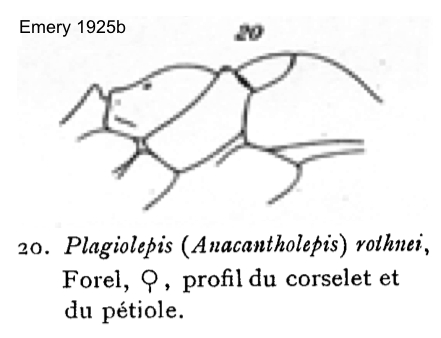 Lepisiota
rothneyi (Plagiolepis
rothneyi nov. spec., Forel, 1894c: 415, worker; placed in Acantholepis (Lepisiota) by
Santschi (1926a) Barrackpore, Rothney (minor worker); Belgaum, Rothney
(major worker) - see below Lepisiota
rothneyi (Plagiolepis
rothneyi nov. spec., Forel, 1894c: 415, worker; placed in Acantholepis (Lepisiota) by
Santschi (1926a) Barrackpore, Rothney (minor worker); Belgaum, Rothney
(major worker) - see below
subspecies
splendida
(Plagiolepis rothneyi For.
subsp. n. splendida
(Viehmeyer, 1916a: 146,
worker) Singapore - no images
on Antweb (September 2015)
sundaica (Plagiolepis (Anacantolepis) Rothneyi
For. subsp. sundaica nov.,
Emery, 1921d: 318,
worker) Borneo, Poulo-Laut,
Doherty - see https://www.antweb.org/specimenImages.do?code=casent0905145
taivanae (Plagiolepis Rothneyi For. r. Taivanae n. stirps, Forel, 1913f:
197, worker) Taiwan, Taihorin,
Kankau - see https://www.antweb.org/specimenImages.do?code=casent0909867
watsonii (Plagiolepis rothneyi r. watsonii Forel, 1894c: 416, worker)
Burma, Watson, also
Thailand, Bangkok,
Sigg - see https://www.antweb.org/specimenImages.do?code=casent0909868
wroughtonii (Plagiolepis Rothneyi r. Wroughtonii n. stirps, Forel,
1902d: 292,
worker) India, Utakamand,
Nilgiris, Wroughton - no images on Antweb (September 2015)
Forel's (1894c) description, with watsonii is at  . Bingham (1903: 320) had it
in his key to Indian Plagiolepis
and a description, with wroughtoni;
these are at . Bingham (1903: 320) had it
in his key to Indian Plagiolepis
and a description, with wroughtoni;
these are at  .
Forel's (1902d) description of wroughtonii
is at .
Forel's (1902d) description of wroughtonii
is at  . Emery's (1912d)
description of sundaica is
at . Emery's (1912d)
description of sundaica is
at  . Forel's (1913f)
description of taivanae is at . Forel's (1913f)
description of taivanae is at
 .
Viehmeyer's (1916a) description of splendida
is at .
Viehmeyer's (1916a) description of splendida
is at  . .
Distinguished by being dimorphic or, if not showing a
size variation, TL 2.5-4.5 mm, major with a wider, squarer head; black,
smooth and shiny, appendages reddish brown; erect hairs sparse and
quite coarse; petiole node low, thick at the base and narrowing to
slightly conical above; gaster very wide, convex and enlarged, gibbous
(humped) anteriorly.
|
 The photomontage of
the
type major worker
from India is collated from http://www.antweb.org/specimen.do?name=casent0909865. The photomontage of
the
type major worker
from India is collated from http://www.antweb.org/specimen.do?name=casent0909865.
Both the major and minor are among the collections listed by Forel (1894c).
|
|
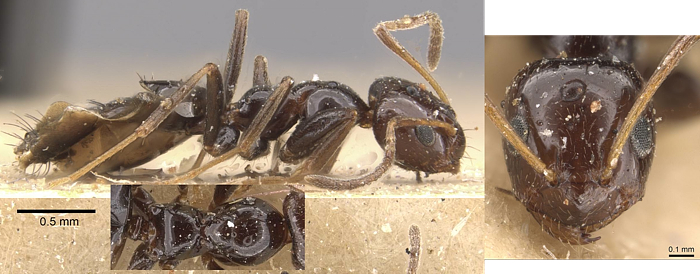 The photomontage of the type minor worker
from India is collated from http://www.antweb.org/specimen.do?name=casent0909866. The photomontage of the type minor worker
from India is collated from http://www.antweb.org/specimen.do?name=casent0909866.
This matches sundaica
and taivanei which also
appear to be Plagiolepis
See a fresh worker at http://www.antweb.org/specimen.do?name=casent0906254.
|
Lepisiota
moelleri
(Plagiolepis moelleri
n. sp., Bingham, 1903: 321, worker) India,
Sikkim, Möller - no images on Antweb (September 2015)
Bingham's (1903) description is at  .
TL 4.5 mm; clypeus with a strong median carina; eyes quite small placed
midway on sides of head, ocelli not mentioned; alitrunk short and
broad, propodeum short and very broad with a distinct angle between
dorsum and declivity; petiole node low and rounded above; head and
alitrunk deep reddish-brown, petiole node and gaster black; very few
erect hairs but long soft pubescence, yellowish on head and alitrunk,
black on gaster .
TL 4.5 mm; clypeus with a strong median carina; eyes quite small placed
midway on sides of head, ocelli not mentioned; alitrunk short and
broad, propodeum short and very broad with a distinct angle between
dorsum and declivity; petiole node low and rounded above; head and
alitrunk deep reddish-brown, petiole node and gaster black; very few
erect hairs but long soft pubescence, yellowish on head and alitrunk,
black on gaster
|
Lepisiota
demangei
(Plagiolepis (Anacantholepis) Demangei
sp. nov., Santschi, 1920h: 172, worker; republished also in 1924c: 21,
worker) Vietnam, Hanoi, Demange
Santschi's (1920h) description is at  . Noted as close to Rothneyi and Watsoni but separated by colour,
brown-red, with the gaster darker, and the quite long and dense
pubescence. Although listed in Bolton (1995: 335) as still in Plagiolepis, Santschi (1926a)
implied it should be in Acantholepis
(Lepisiota). The type specimen - casent0912417 - shows this
quite clearly to be a Plagiolepis,
which is where Antweb have it. . Noted as close to Rothneyi and Watsoni but separated by colour,
brown-red, with the gaster darker, and the quite long and dense
pubescence. Although listed in Bolton (1995: 335) as still in Plagiolepis, Santschi (1926a)
implied it should be in Acantholepis
(Lepisiota). The type specimen - casent0912417 - shows this
quite clearly to be a Plagiolepis,
which is where Antweb have it.
TL 3-4 mm; head rectangular, sides slightly convex;
clypeus convex and with a strong carina; eyes flat about one-third
length of head; ocelli developed; scape surpasses occiput by about 1/6
its own length; alitrunk as watsoni,
propodeum wide and in profile rounded with an arcuate transition from
dorsum to declivity; petiole
low, vertical in front and with an oblique posterior face;
brownish-red, gaster a little darker, appendages pale red; erect
pilosity quite abundant all over.
|
B. Lepisiota
frauenfeldi and Lepisiota capensis-group species
Forel's (1894: 412 ff) key to Indian species, frauenfeldi-group
is at  .
See also Lepisiota frauenfeldi
page. .
See also Lepisiota frauenfeldi
page.
|
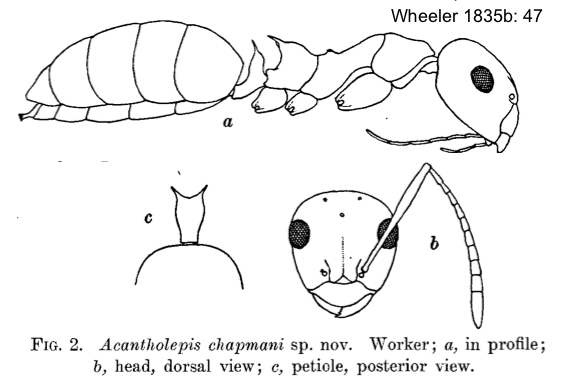 Lepisiota chapmani (Acantholepis chapmani sp. nov.,
Wheeler 1935b: 47, worker) from Philippines,
Dumaguete, Negros Oriental, Dr J W Chapman - no images on Antweb
(September 2015) Lepisiota chapmani (Acantholepis chapmani sp. nov.,
Wheeler 1935b: 47, worker) from Philippines,
Dumaguete, Negros Oriental, Dr J W Chapman - no images on Antweb
(September 2015)
Wheeler's (1935b) description is at  . .
TL 2.5-2.8 mm; shape more elongated, as with frauenfeldi; overall shiny with
very fine reticulation, posterior alitrunk duller.
|
Lepisiota
sericea
(Acantholepis frauenfeldi var.
sericea n. var.,
Forel, 1892a: 41, solely as diagnosis in key; worker) India, no location given
 Forel's brief separation from the type frauenfeldi is TL 3-3.5 mm; head
more flattened and wider, especially posteriorly; subopaque and silky;
dark brown; propodeum bispinose; India. Forel's brief separation from the type frauenfeldi is TL 3-3.5 mm; head
more flattened and wider, especially posteriorly; subopaque and silky;
dark brown; propodeum bispinose; India.
|
C. Lepisiota
capensis-group species; with short spines/teeth
on petiole and blunt propodeal spines
Forel's (1894: 412 ff) key to Indian species, capensis-group
is at  . .
|
Black species
|
 Lepisiota
annandelei (Acantholepis
annandelei sp. nov., Mukerjee, 1930: 156, illustrated, worker) India,
Simla, alt 7000', Dr N Annandale - no images on Antweb (September 2015) Lepisiota
annandelei (Acantholepis
annandelei sp. nov., Mukerjee, 1930: 156, illustrated, worker) India,
Simla, alt 7000', Dr N Annandale - no images on Antweb (September 2015)
Mukerjee's (1930) description is at  . .
TL 2 mm; scapes exceeding occiput by about half their
length; propodeum with short, conical, blunt spines; petiole with
minute straight spines; black, gaster shiny; erect hairs few limited to
head and apex of gaster.
|
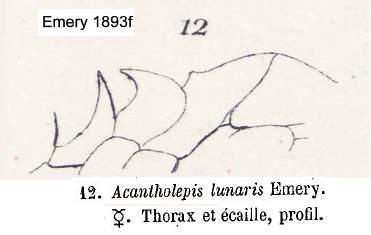 Lepisiota
lunaris
(Acantholepis lunaris n. sp.,
Emery, 1893f: 250, illustrated (unavailable on HNS) worker) Sri Lanka, Colombo Lepisiota
lunaris
(Acantholepis lunaris n. sp.,
Emery, 1893f: 250, illustrated (unavailable on HNS) worker) Sri Lanka, Colombo
Emery's (1893) description is at  .
TL 2-2.3 mm, separable from L.
capensis by having long sharp spines on the petiole; also
smoother, the gaster very shiny; scape surpasses occiput by 1/3 of its
length; erect hairs large, obtuse and moderately abundant; black, with
most of appendages reddish. .
TL 2-2.3 mm, separable from L.
capensis by having long sharp spines on the petiole; also
smoother, the gaster very shiny; scape surpasses occiput by 1/3 of its
length; erect hairs large, obtuse and moderately abundant; black, with
most of appendages reddish.
|
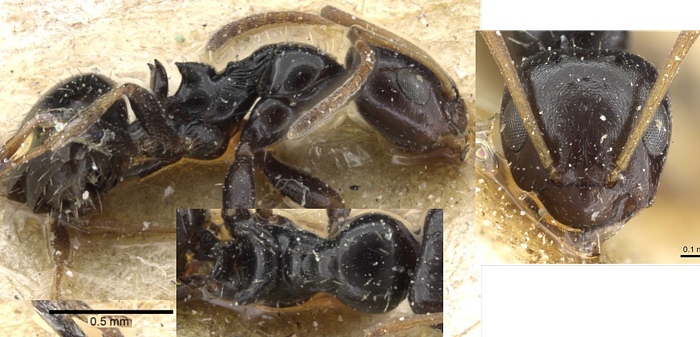
|
Partially or
wholly golden to
reddish-yellow species
|
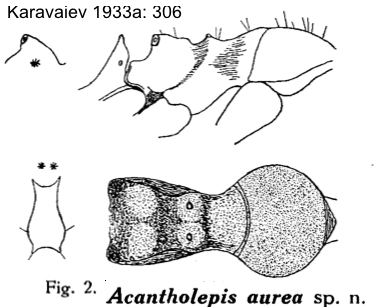 Lepisiota
aurea (Acantholepis
aurea
sp. n., Karavaiev, 1933a: 306, illustrated, worker) Indonesia, Meeuwen Island, 6°43'60"S
105°15'0"E - no images on Antweb (September 2015) Lepisiota
aurea (Acantholepis
aurea
sp. n., Karavaiev, 1933a: 306, illustrated, worker) Indonesia, Meeuwen Island, 6°43'60"S
105°15'0"E - no images on Antweb (September 2015)
subspecies punctaticeps (Acantholepis
aurea Karawajew subsp. punctaticeps
subsp. nov. Wheeler 1935b: 46, worker) from Philippines, Baguioa, Luzon Is. - no
images on Antweb (September 2015)
Karavaiev's (1933) description
is at  . Wheeler's (1935b)
description of punctaticeps
is at . Wheeler's (1935b)
description of punctaticeps
is at  . .
TL 2 mm; overall finely sculptured and semi-matt; head,
alitrunk and base of gaster golden yellow, apex of gaster black; erect
hairs pale; punctaticeps
somewhat darker.
|
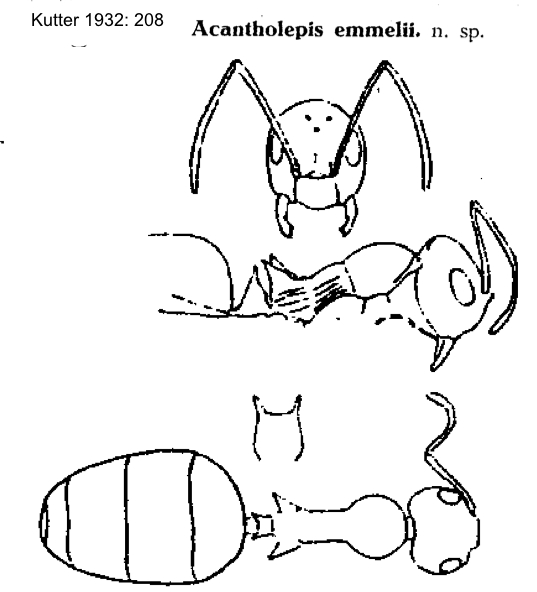 Lepisiota emmelii (Acantholepis emmelii n. sp.,
Kutter, 1932: 208, illustrated, worker) from Indonesia, Java, Sarangan, H
Overbeck, 1927 Lepisiota emmelii (Acantholepis emmelii n. sp.,
Kutter, 1932: 208, illustrated, worker) from Indonesia, Java, Sarangan, H
Overbeck, 1927
Kutter's (1932) description is at  .
Gaster only remains of type specimen (confirms colour) - see http://www.antweb.org/specimenImages.do?code=casent0907587 .
Gaster only remains of type specimen (confirms colour) - see http://www.antweb.org/specimenImages.do?code=casent0907587
TL 2.6-2.8 mm; body gold to reddish gold; erect hairs
absent or very sparse.
|
Lepisiota
fergusoni (Acantholepis
fergusoni n.
sp., Forel, 1895e: 459, worker) India,
Travancore, Ferguson
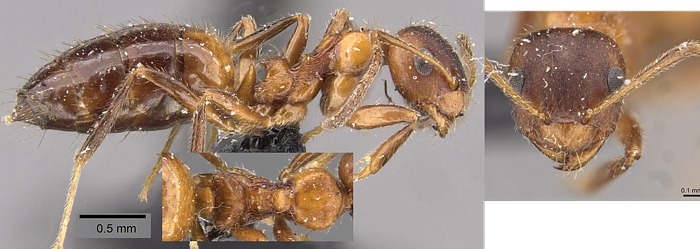 Forel's (1895e) description is at Forel's (1895e) description is at  .
TL 2.7-3.3 mm, comparison with opaca;
erect pilosity abundant, fine and yellowish; overall reddish-yellow,
apex of gaster blackish; legs and antennae yellowish-brown. .
TL 2.7-3.3 mm, comparison with opaca;
erect pilosity abundant, fine and yellowish; overall reddish-yellow,
apex of gaster blackish; legs and antennae yellowish-brown.
The type specimen image is collated from https://www.antweb.org/specimenImages.do?code=casent0909883
This is slightly odd as it is on a modern mount and is
very clean although there is no label to indicate such treatment.
|
Lepisiota
modesta
(Acantholepis modesta n. sp.,
Forel, 1894c: 412, diagnosis in key, worker) India, Mussoorie, Rothney
 Forel's (1894c) description is at Forel's (1894c) description is at  .
TL 2.3 mm, separable from L.
capensis by being more slender; head narrow, ovoid distinctly
longer than wide; propodeum with strong obtuse teeth; petiole
bispinose, with lateral angles below the spines [cf bipartita-group on Lepisiota frauenfeldi
page]; erect pilosity long, fine, and abundant; alitrunk and petiole
yellowish red, with brown patches dorsally. .
TL 2.3 mm, separable from L.
capensis by being more slender; head narrow, ovoid distinctly
longer than wide; propodeum with strong obtuse teeth; petiole
bispinose, with lateral angles below the spines [cf bipartita-group on Lepisiota frauenfeldi
page]; erect pilosity long, fine, and abundant; alitrunk and petiole
yellowish red, with brown patches dorsally.
Type images collated from https://www.antweb.org/specimenImages.do?code=casent0909892
|
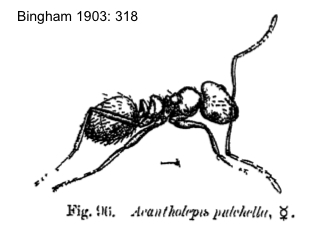 Lepisiota opaca
(Acantholepis opaca n. sp.,
Forel, 1892a: 5, diagnosis in key, worker) India,
Kanara, M Aitken Lepisiota opaca
(Acantholepis opaca n. sp.,
Forel, 1892a: 5, diagnosis in key, worker) India,
Kanara, M Aitken
stirps pulchella (Acantholepis pulchella (Forel, 1892a:
43, diagnosis in key;,worker) India,
Poona, Wroughton
Forel's (1892a) descriptions are at  .
Bingham (1903: 319) treated them as separate species; his illustrated
note is at .
Bingham (1903: 319) treated them as separate species; his illustrated
note is at  .
TL 2-2.3 mm, separable from L.
capensis by a thicker petiole with long sharp spines; matt and
densely reticulo-punctate, but gaster shiny; head near square; scape
surpasses occiput by 1/3 of its
length; erect hairs yellowish, short and quite sparse; ferruginous red
to gaster brownish black, with
most of appendages reddish; pulchella
with gaster subopaque and strongly reticulated. .
TL 2-2.3 mm, separable from L.
capensis by a thicker petiole with long sharp spines; matt and
densely reticulo-punctate, but gaster shiny; head near square; scape
surpasses occiput by 1/3 of its
length; erect hairs yellowish, short and quite sparse; ferruginous red
to gaster brownish black, with
most of appendages reddish; pulchella
with gaster subopaque and strongly reticulated.
The badly damaged type worker can be seen at - http://www.antweb.org/specimenImages.do?code=casent0905158
The similar worker below is collated from https://www.antweb.org/specimenImages.do?code=casent0906255
The type of pulchella
can be seen at http://www.antweb.org/specimenImages.do?code=casent0909894
|
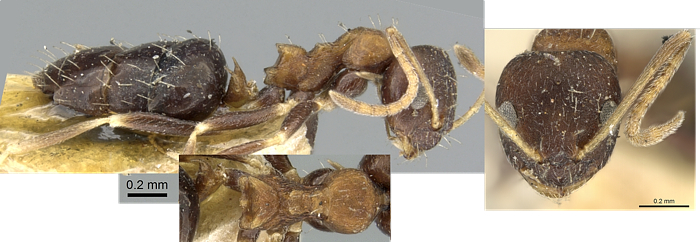
|
Wu & Wang. 1995. [The
ants of China] China Forestry
Publishing House, Beijing. 214 pp; in Chinese (unavailable on HNS).
Xu. 1994. A taxonomic study of the ant genus Lepisiota Santschi from
Southwestern China (Hymenoptera Formicidae Formicinae) Journal of Southwest Forestry College,
14(4): 232-237; in
Chinese
An illustrated version of the English abstract from Xu
(1994) is as follows: 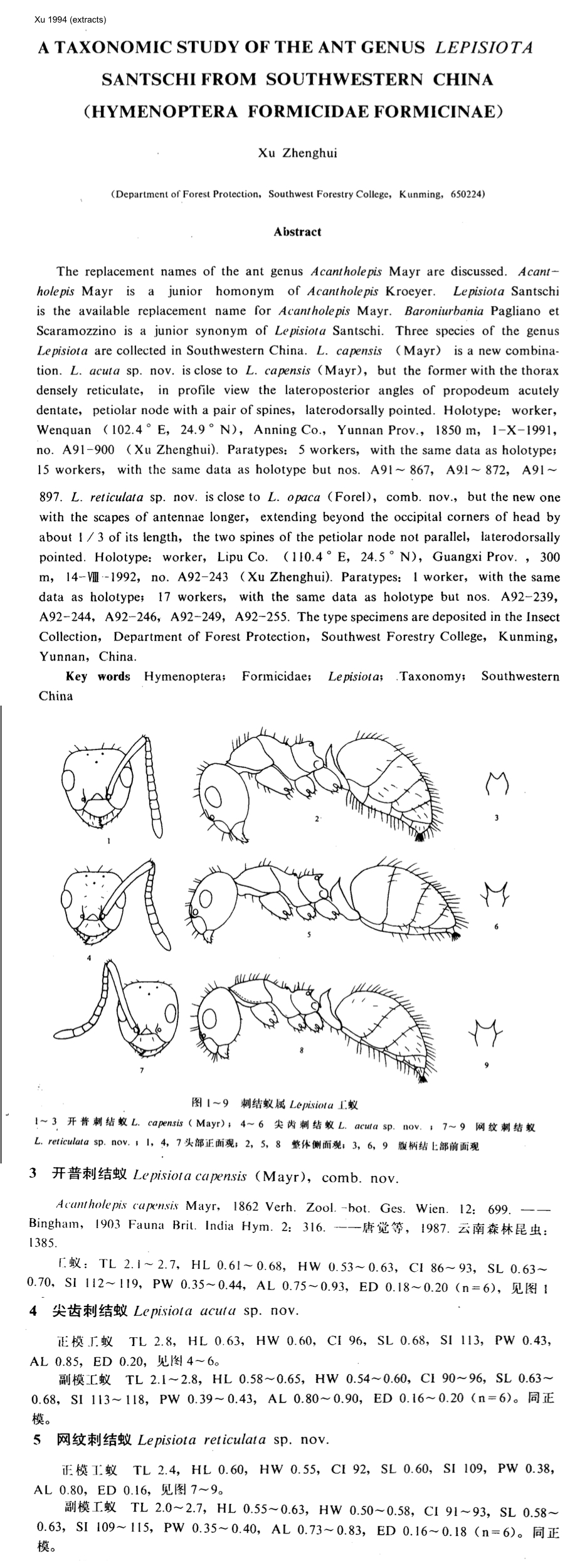 . .
|
|